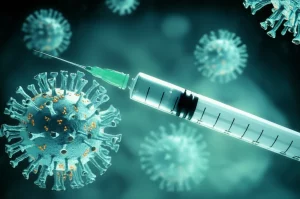Zapping the Spike: Electromagnetic Waves Weaken COVID Virus Particles
Hey there, science enthusiasts! Let’s talk about something really cool and potentially game-changing in the fight against viruses like SARS-CoV-2. We’ve all lived through the COVID-19 pandemic, and while we have vaccines and treatments, this sneaky virus is still circulating. We desperately need new tools in our arsenal, right? Well, imagine using something as ubiquitous as electromagnetic waves to help tackle the problem.
The Challenge: Finding New Ways to Fight COVID
Coronaviruses, as we’ve learned, can cause everything from a mild cold to severe disease. SARS-CoV-2, the culprit behind COVID-19, spreads through droplets, contact, and touching contaminated surfaces. Despite our best efforts with vaccines and therapies, it continues to pose a global health concern. Standard disinfection methods like heat, UV light, and chemicals work, but they have limitations. UV, for instance, doesn’t penetrate surfaces well, and some methods can leave behind nasty byproducts.
Enter Electromagnetic Waves: A Novel Approach
This is where electromagnetic waves step in as a fascinating alternative. Think of them as having high penetration power, offering uniform treatment, and causing minimal pollution. Scientists have been exploring how these waves affect viruses – maybe by changing their shape, damaging their genetic material, or messing with their surface proteins.
Building the Experiment: Virus-Like Particles and Special Tech
The key to SARS-CoV-2 infection is its Spike protein. It’s like the key that unlocks the door to our cells, specifically by binding to a receptor called ACE2. This study wanted to see if electromagnetic waves could mess with this crucial step. Working with the live SARS-CoV-2 virus requires high-level biosafety labs (BSL3), which aren’t always accessible. So, the clever folks in this study used something called SARS-CoV-2 Virus-Like Particles (SC2-VLPs). These are like empty shells that have the essential SARS-CoV-2 structural proteins (Spike, Nucleocapsid, Envelope, Membrane) on their surface, just like the real virus. They can even deliver genetic material into cells, mimicking how the real virus enters. They’re a much safer way to study viral entry and assembly in a BSL2 setting.
To figure out which electromagnetic wave frequencies might affect these VLPs, they used a neat setup involving a coplanar waveguide (CPW) and a Vector Network Analyzer (VNA). Imagine the CPW as a tiny track where they placed the VLP solution. The VNA sends out waves across thousands of frequencies and measures how much is absorbed. It’s like finding the frequencies the VLPs “resonate” with or absorb energy from most effectively.

Finding the “Sweet Spot”: Which Frequencies Work?
Using the CPW/VNA setup, they found that the SC2-VLPs showed absorption peaks around 3.1 GHz and 6 GHz. This gave them a clue about which frequencies might be interesting to test for reducing infectivity. They then exposed the SC2-VLPs to a range of frequencies (1–6 GHz) using a device called a Transverse Electromagnetic (TEM) cell, which can generate powerful electric fields. They also used microwave (MW) radiation at 2.45 GHz as a control, since that’s known to inactivate other viruses and even denature the Spike protein in test tubes.
After zapping the VLPs, they tested how well they could infect target cells (cells designed to be susceptible to SARS-CoV-2 entry, containing the ACE2 and TMPRSS2 receptors). The results were pretty exciting! While both electromagnetic waves and microwaves reduced infectivity to some degree, the strongest reduction happened when the SC2-VLPs were exposed to frequencies between 2.5 and 3.5 GHz. This range lines up nicely with one of the absorption peaks they found earlier (around 3.1 GHz).
Unpacking the Mystery: How Do the Waves Work?
So, the waves reduce infectivity, but *how*? Two main ideas were on the table: either the waves physically destroy the virus particles, or they change the shape (the conformation) of the Spike protein, making it unable to do its job.
To check if the particles were destroyed, they looked at the levels of the different structural proteins (Spike, Nucleocapsid, Envelope, Membrane) in the zapped VLPs using a technique called Western blot. If the particles were breaking apart, the protein levels should drop, right? But they didn’t see any significant changes in the amounts of these proteins after exposure to the effective frequencies (3.1 GHz and 5.9 GHz). This suggests the waves weren’t just blowing up the VLPs.
The Spike Protein Gets a Jiggle
This led them to the second hypothesis: maybe the waves were altering the Spike protein’s shape. To test this, they used an ELISA (Enzyme-Linked Immunosorbent Assay) to see how well the treated SC2-VLPs could bind to an antibody that specifically targets the S1 receptor-binding domain (S1 RBD) of the Spike protein. Remember, the S1 RBD is the part that grabs onto our ACE2 receptors. If the Spike protein’s shape is changed, the antibody might not be able to bind to it as effectively.
And that’s exactly what they found! SC2-VLPs exposed to 3.1 GHz waves showed a significant reduction (about 70%) in binding to the S1 RBD antibody. Exposure to 5.9 GHz also reduced binding, though to a lesser extent (about 15%). This is strong evidence supporting the idea that the electromagnetic waves are causing a conformational change in the Spike protein, specifically in the crucial S1 RBD area. It’s like the waves are subtly twisting or bending the Spike protein, making it harder for it to bind to antibodies and, presumably, to our cell receptors like ACE2.

Importantly, the study suggests this effect is likely nonthermal. They didn’t detect significant temperature increases during the experiments. This is different from some other methods that rely on heating to inactivate viruses. Nonthermal effects mean the waves are directly interacting with the molecules, causing them to vibrate or rotate in a way that changes their structure, rather than just cooking them.
Beyond the Lab: Real-World Potential
This study provides a fantastic proof-of-concept. It shows that electromagnetic waves, at specific frequencies and field strengths, can reduce the infectivity of SARS-CoV-2 virus-like particles by messing with the Spike protein’s conformation. This opens up exciting possibilities for using electromagnetic waves for sanitation and prevention.
Imagine portable devices that use these waves to disinfect surfaces in hospitals, especially sensitive equipment that can’t handle heat or harsh chemicals. Or think about integrating this technology into HVAC systems to continuously inactivate airborne viruses in places like labs or hospital wards. The potential applications are vast!
Why Waves Might Beat UV-C (Sometimes!)
Compared to UV-C light, which is often used for disinfection, electromagnetic waves offer some potential advantages:
- Penetration: UV-C is great for surfaces but doesn’t penetrate materials well. Electromagnetic waves can pass through a wider variety of substances, making them potentially useful for disinfecting objects or even air flowing through ducts.
- Mechanism: UV-C primarily damages viral genetic material (RNA/DNA). Electromagnetic waves, as this study shows, can also directly disrupt viral proteins like Spike, offering another way to inactivate the virus.
- Byproducts: UV-C lamps can produce harmful ozone or contain mercury. Electromagnetic waves don’t have these issues.
- Integration e Cost: While long-term costs need more study, the idea of integrating wave-based systems into existing infrastructure like HVAC could be more scalable and potentially cost-effective over time compared to replacing UV lamps.
- Safety: Prolonged exposure to UV-C can be harmful to skin and eyes. While more research is needed on the safety of the specific frequencies used here for humans, other forms of electromagnetic fields (like low-frequency PEMF therapy) are already FDA-approved for certain medical uses. Combining different methods might be the ultimate solution!

The Road Ahead: Limitations and Future Steps
Of course, this is just one study, and it has limitations. They used SC2-VLPs, not the actual infectious SARS-CoV-2 virus. While VLPs are great models, testing with the real virus in a BSL3 lab is the next crucial step. They also used the Spike protein from the original Wuhan-1 strain. While simulations suggest electromagnetic fields might affect variants too, experimental testing is needed to confirm this.
It would also be interesting to use electron microscopy to definitively rule out any subtle physical damage to the VLPs, even if protein levels weren’t reduced. And most importantly, extensive research is required to determine if the frequencies and power levels effective against the virus are safe for human cells and tissues if used in environments where people are present.
Exciting Possibilities for the Future
Despite the limitations, this research is incredibly promising. It shows that electromagnetic waves can be a powerful tool against enveloped viruses like SARS-CoV-2. Beyond just inactivation, the CPW technique used here could potentially be adapted to *detect* viruses based on their unique absorption characteristics. Imagine a portable device that could quickly scan for viruses in samples!
Overall, this study gives us hope for novel approaches in viral detection, inactivation, and sanitation. It’s a fascinating peek into how physics and biology can intersect to help us tackle global health challenges.
Source: Springer







